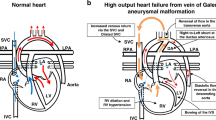Abstract
Introduction
Vein of Galen malformation (VGM) is the severest paediatric neurovascular disease usually requiring multiple staged embolisations. In the high-risk group of children with high-flow arteriovenous shunts, timing of treatment is uncertain. Low Doppler resistance index (RI) is known to be associated with adverse outcome in hypoxic-ischaemic brain injury in children. In this study, we want to present our long-term results of cranial transfontanellar Doppler ultrasound in children with VGM.
Methods
We identified and retrospectively analysed 264 transfontanellar Doppler measurements in 19 endovascular-treated true VGM (five females, 14 males) between 2000 and 2013. The recordings were obtained from the internal carotid arteries (ICA), the anterior cerebral arteries (ACA) and the basilar arteries (BA). Maximal systolic velocity (Vs), end-diastolic velocity (Ved) and the RI were measured before and after embolisation.
Results
Untreated, nearly all cases showed pathologic high systolic (up to >1.0 m/s), very high diastolic velocities (up to >0.5 m/s) and low RI (<0.6). There were statistically significant differences (p = 0.012) between the pre-embolisation RI and the post-embolisation RI with pathologic low RI before and nearly normal RI after successful shunt reduction.
Conclusion
Successful endovascular shunt reduction in VGM leads to significant changes of cranial Doppler RI from pathologic low values to normal values. We propose cranial Doppler ultrasound as an adjunctive technique to other screenings in the management of VGM. Further research is warranted to evaluate the role of the RI in the treatment timing decision.







Similar content being viewed by others
References
Lasjaunias P, Berenstein A, terBrugge K (2006) Surgical neuroangiography: clinical and interventional aspects in children. Springer, Berlin
Meila D, Hannak R, Feldkamp A, Schlunz-Hendann M, Mangold A, Jacobs C, Papke K, Brassel F (2012) Vein of Galen aneurysmal malformation: combined transvenous and transarterial method using a “kissing microcatheter technique”. Neuroradiology 54(1):51–59
Berenstein A, Fifi JT, Niimi Y et al (2012) Vein of Galen malformations in neonates: new management paradigms for improving outcomes. Neurosurgery 70(5):1207–1213, discussion 1213–4
Archer LN, Levene MI, Evans DH (1986) Cerebral artery Doppler ultrasonography for prediction of outcome after perinatal asphyxia. Lancet 2(8516):1116–1118
Gray PH, Tudehope DI, Masel JP, Burns YR, Mohay HA, O’Callaghan MJ, Williams GM (1993) Perinatal hypoxic-ischaemic brain injury: prediction of outcome. Dev Med Child Neurol 35(11):965–973
Pourcelot L (1974) Applications cliniques de l’examen Doppler transcutane. In: Peronneau P (ed) Velocimetrie ultrasonore Doppler. INSERM 34, 213–240
Deeg KH (1989) Color flow imaging of the great intracranial arteries in infants. Neuroradiology 31:40–43
Deeg KH, Rupprecht T (1989) Pulsed Doppler sonographic measurement of normal values for the flow velocities in the intracranial arteries of healthy newborns. Pediatr Radiol 19:71–78
Jones BV, Ball WS, Tomsick TA, Millard J, Crone KR (2002) Vein of Galen aneurysmal malformation: diagnosis and treatment of 13 children with extended clinical follow-up. AJNR Am J Neuroradiol 23:1717–1724
Deeg KH, Scharf J (1990) Colour Doppler imaging of arteriovenous malformation of the vein of Galen in a newborn. Neuroradiology 32:60–63
Tessler FN, Dion J, Vinuela F et al (1989) Cranial arteriovenous malformations in neonates: color Doppler imaging with angiographic correlation. AJR 150:1027–1030
Abbitt PL, Hurst RW, Ferguson RDG et al (1990) The role of ultrasound in the management of vein of Galen aneurysms in infancy. Neuroradiology 32:86–89
Levene MI, Fenton AC, Evans DH, Archer LN, Shortland DB, Gibson NA (1989) Severe birth asphyxia and abnormal cerebral blood-flow velocity. Dev Med Child Neurol 31(4):427–434
Nishimaki S, Iwasaki S, Minamisawa S, Seki K, Yokota S (2008) Blood flow velocities in the anterior cerebral artery and basilar artery in asphyxiated infants. J Ultrasound Med 27(6):955–960
Geibprasert S, Krings T, Armstrong D, terBrugge KG, Raybaud CA (2010) Predicting factors for the follow-up outcome and management decisions in vein of Galen aneurysmal malformations. Childs Nerv Syst 26:35–46
Ethical standards and patient consent
We declare that this manuscript does not contain clinical studies or patient data.
Conflict of interest
We declare that we have no conflict of interest.
Author information
Authors and Affiliations
Corresponding author
Additional information
Dan Meila and Kathrin Lisseck contributed equally to this work.
Rights and permissions
About this article
Cite this article
Meila, D., Lisseck, K., Jacobs, C. et al. Cranial Doppler ultrasound in Vein of Galen malformation. Neuroradiology 57, 211–219 (2015). https://doi.org/10.1007/s00234-014-1455-7
Received:
Accepted:
Published:
Issue Date:
DOI: https://doi.org/10.1007/s00234-014-1455-7




